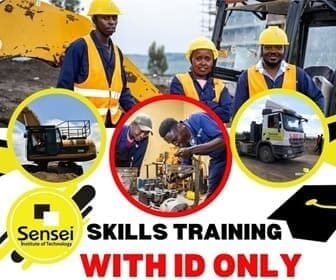
Were it not for a chance encounter at an American University campus, we would probably not be telling this story of Kenyan-born Rachel Nyameyo, who dreamt of being a supermodel but ended up joining the world’s most powerful army.
It was a routine afternoon at a university in Texas in 2014 and all Rachel was thinking about was lunch before continuing with her coursework.
But as she walked across campus, she caught the attention of a uniformed military man nearby. It had to do with her height and poise and whatever else his expert eye saw in her.
He waved at her. Not once; not twice. She thought it was someone who had recognised her.
“I moved closer to see who it was then realised that I actually didn’t know him,” she says.
Rachel soon realised why she had attracted his attention: He thought she was a good candidate to join the military.
Having been a model for years, a career as a soldier had never crossed her mind. But the prospect that had just been presented to her sounded interesting.
There was only one problem: Rachel was neither a US citizen nor did she have a Green Card, which would make her eligible.
But how did this 37-year-old who grew up in Kenya’s lakeside city of Kisumu find herself in Texas in the first place?
It started with modelling. In her formative years, Rachel was raised by a strict mother. Life revolved around school, church and home. But even then, she would still sneak out of the house to visit her friends.
“My favourite subject in high school was geography, simply because the teacher was a cool dude and I didn’t want to do the alternative which was either commerce or accounts,” says Rachel.
After high school, she came across a flyer on Surazuri Casting and Consultancy that was being run by Lyndsey McIntyre.
Rachel saw this as her best route to a modelling career but she knew she had to move to Nairobi to make her dream come true.
So, in 2003, she arrived in the capital city. But to her frustration, she was unable to reach the agency using the contacts on the flyer and ended up studying fashion design at Vera Beauty and Fashion College.
At the college, she found out they organised events and started runway modelling, getting into competitions and even appeared in the media.
Rachel appeared as a model in pictures for Daily Nation articles and was the face of KWAL’s Tropical Breeze Ice beverage. She was also part of the hostesses who welcomed Nelson Mandela in Kenya in 2005.
And it kept getting better. Rachel competed in the four top pageants: Miss Tourism Kenya, Miss Earth Kenya, Miss Kenya and Miss Universe.
“The one that really stood out for me was Miss Universe/Smile of Africa because most of us (contestants) have remained friends. The year that we did it, 2003, it was one main event but four titles were handed out,” says Rachel.
She did everything that was coming her way and moved to international events. She participated in Miss Tourism Queen of the Year International, in China, in 2004.
Immediately after returning, she went back to China for Miss Model of the World and then Miss International. She started getting invitations to judge international competitions.
In 2006, she was a judge for the top pageants Ethiopia. In 2007, she was invited to Ethiopia’s millennial celebrations where she got to sit front-side for Beyoncé’s performance.
Outside of her busy schedule in this glamorous world, she was working as an executive assistant to a board member at Standard Investment Bank.
One day she came across an online advertisement on studying in the US and applied just for the sake of it.
To her delight, she got accepted and in 2009, Rachel moved to Houston to study for a Bachelor of Science degree in biology at Texas Southern University (TSU).
However, Rachel had wanted to study pharmacy and the university offered a doctorate course she qualifies for. She decided to pursue this. “I got accepted into the Doctor of Pharmacy programme at the same institution just when I was wrapping up my bachelor’s degree,” she says.
Rachel worked her way to getting a scholarship from the university as well as a waiver that provided a bit of relief, especially as an international student.
Even with that, she required about $13,500 (Sh1.5 million in today’s rates) per semester as the total tuition fees before including expenses for housing and books.
“One day, I was just done with these expenses. It was finals week (exams week) and I had gone to get food. Walking towards the food court at the student centre, I saw someone in military uniform persistently waving at me,” she says.
That was how she first interacted with the military recruiter.
After telling him that she didn’t have a Green Card, he asked her if she spoke any other languages.
“I told him Kiswahili,” she said.
Rachel gave him her number and they went their separate ways. At 6pm, she got a call from an unknown number.
“Hi! We spoke earlier today and I just wanted to tell you that I spoke to my boss and he said you could join a language programme (which has since been discontinued),” she heard the voice from the other side say.
He said his boss had more information about the programme. The next day, she found a missed call after her examination. Then, immediately she was called again and the military man said he was at the student centre and that was the last day of the recruitment.
“I was exhausted; I’m coming from doing exams the whole week and had been stressed about how I was going to pay for the coming semester. So, I decided to go and listen to what they had to tell me,” says Rachel, who was also tutoring students in maths, chemistry and biology to make ends meet.
She was given an English and maths exam at the centre and she performed well.
“What was this for?” She asked.
“To get you in,” he replied.
Up until that point he hadn’t asked her expressly to try out for the army, so she was taken aback by his approach.
“You just do whatever I’m asking you to do,” he said.
She was picked up later and taken to a Military Entrance Processing Station, where she did the main written exam along with physical and medical check-ups, and also verified to be a Kiswahili speaker in her Oral Proficiency Interview by speaking with someone from the military in the language as a test.
“It’s just a way of assessing how well a person speaks a language, in my case Kiswahili,” Rachel says.
Then she had to wait for a vacancy to be available. In mid-2014 she signed a contract and was sworn in before starting her role in early 2015.
After choosing her military job of combat medic, she was ready to go into the boot camp. It wasn’t until the eve of going away that it hit her that she was going to join the military as she watched YouTube videos of what happens in boot camps.
“I had been preoccupied with exams, ending the lease to my apartment and also dropping my classes. Now, reality was sinking in that I had actually signed up to join the military,” says Rachel, adding it was at this point she told her brother because she had not wanted to be talked out of the decision.
The benefits included full tuition pay, accommodation and medical coverage.
She says it was tough at the boot camp but her worst experience was “the night of the death crawl”.
The recruits climb up a ladder that brings them to a ground with gravel and sand. They have to crawl a distance of about 100 metres with their really heavy gear on them underneath a low, barbed wire roof spread throughout the course.
“Then you have drill sergeants shooting live bullets just above your heads as you try to make it to the other side. We were crying mid-course because you’re tired but you can’t stop and you can’t turn back since there are others also coming in behind you,” Rachel says.
More trouble followed as she lost her elbow and knee pads, and only realised how bruised and cut her skin was while she was taking a shower afterwards.
There was also walking through a chamber, which contains concentrated tear gas and they had to have their eyes open the whole time.
But despite being tough, she says boot camp was rewarding. She made friends with a lot of the other recruits through sharing in their hardship as they “embraced the suck”.
She graduated after two months, transformed from a civilian into a soldier. She then went through an advanced individual training — for combat medic training—before being stationed at Fort Bragg, North Carolina with a hospital unit at Womack Army Medical Centre.
“My station was a whole city, complete with shopping complexes and a hospital. It is the biggest military installation in the world by population. I worked in family medicine department and in the emergency department and would take care of the military, their families and veterans. We are taught how to take care of all types of trauma injuries as combat medics, some of which we’d generally not be able to do as civilians as they require specialisation or more certification,” says Rachel, noting that combat medics usually go on patrols with the soldiers when deployed, so they are taught how to take care of injuries caused by gun shots or explosive devices before the injured get to the doctors.
As active duty members, they would be up by 4am daily for training, which was timed. They would then take a shower and report to their stations. She would work 12-hour shifts a day and sometimes even longer.
The military is supportive, even of relationships formed within the military, because of the long periods soldiers spend together. And looking out for each other is important, she says. In her first week at the installation, Rachel felt people were too nosy because they kept asking her all these personal questions—but she realised they just wanted to know more about her. All single soldiers have to live within the barracks (living quarters), unless they are of certain ranks.
Rachel moved to Houston, Texas, during the onset of Covid-19 in 2020, now a member of the US Army Reserve— part-military, part-civilian with the 420th Engineering Brigade. While still on active duty, she got injured and she was constantly in pain, which made it harder for her to keep up with the physical demands of training. The final straw was an injury on her ankle one morning as they were doing a 12-mile (19.3 kilometres) ruck march at 4am. With 80 pounds (36.2 kilogrammes) on her back, she tripped as she was racing against time in the dark bushy area. Since then, her ankle has never been the same.
“I had a come-to-Jesus moment and told myself that I needed to take a break after going through a major surgery to take care of the issues I was going through. I only had three months left on my first four years of the eight-year contract the military gives out.”
She wasn’t quite ready to leave the military; so she transferred from active duty to the reserve. However, she can be activated at any moment should her team, an engineering unit now, need a medic as they work in different areas. As a civilian, Rachel is a quality analyst for a company contracted by the Veteran’s Administration.
She misses her “battle buddies” whom she had grown close to and who visited her and took care of her, sat with her in hospital and took her home afterwards, and visited her to ensure she was faring well. Even though she likes that she can now do what she wants now as a civilian, she has extended her enlistment as her eight years were to be due in July 2022.
“I don’t know if I want to be out, I’m still trying to listen to my body. If I got out completely (without transferring to the reserves) then I’d have to go back through basic training if I wanted to come back in later,” says Rachel.
She tried to get back into her former university to complete her doctorate programme at TSU, but she was told that she had to do the entrance exam again and get recommendation letters.
“With professional courses, they assume after a year that you’ve forgotten everything. But if I have to go through the whole process again then I might as well apply elsewhere,” she says.
For now, her focus remains on the master’s degree she is pursuing and she has no regrets for choosing the military over her modelling dream. BY DAILY NATION
Kenyan-born Rachel Nyameyo Gave Up Modelling Dream To Be US Soldier






